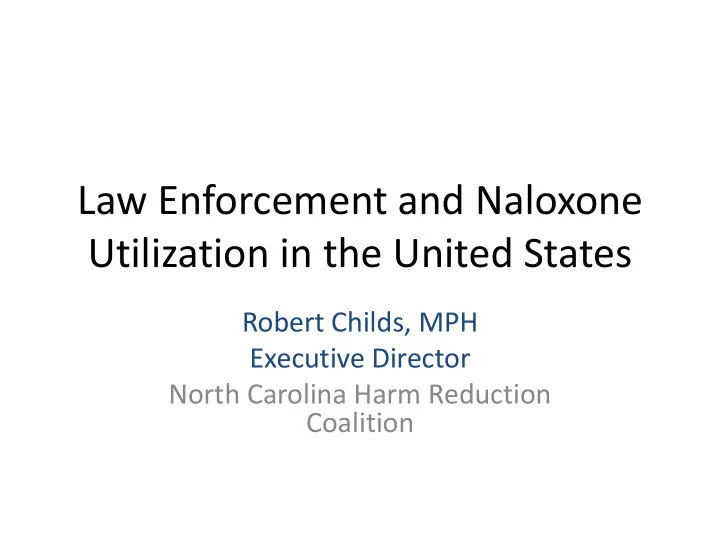

Law Enforcement and Naloxone Utilization in the United States Robert Childs, MPH Executive Director North Carolina Harm Reduction Coalition
Overview • US Law Enforcement ( LE ) Naloxone Programs • NC LE Naloxone Programs • NC LE Attitudes Towards Carrying Naloxone • EMS and Law Enforcement Cooperation to Decrease Overdose Mortality • Implementation • Resources
US Law Enforcement Naloxone Programs
Departments Carrying Naloxone by State- June 12, 2015 California – 2 New Jersey - 129 Colorado - 2 (New, Not on Map) New Mexico - 3 New York – 212 Connecticut - 4 North Carolina - 16 Delaware - 1 Oklahoma - 1 Georgia - 18 Ohio - 30 Illinois - 50 Oregon - 4 Indiana - 9 Pennsylvania - 14 Kentucky - 3 Rhode Island - 8 Maine - 2 Tennessee - 1 Maryland - 8 Vermont - 1 Massachusetts - 42 Virginia - 1 Michigan - 3 Washington - 3 Minnesota – 1 Wisconsin - 9
US Spotlight: Quincy PD, MA Most Successful US Law Enforcement Naloxone Program • Data Period 10/1/2010- 6/11/2015 • First Naloxone Rescue: Nov 2010 • 419 Naloxone Administrations • 402 Rescues Lt. Det. Pat Glynn, Quincy PD, speaking at a law enforcement summit in North Carolina
North Carolina Law Enforcement Naloxone Program
Greenville PD (NC) Four Overdose Rescues With Naloxone in 24 Hour Period in March 2015
Chief Harold Medlock, Fayetteville PD, NC
NC Law Enforcement Attitudes Towards Naloxone NCHRC Preliminary Study Results On Law Enforcement Attitudes Towards Syringe Criminalization and Drug Overdose, 2015
NC Law Enforcement Attitudes Towards Naloxone NCHRC Preliminary Study Results On Law Enforcement Attitudes Towards Syringe Criminalization and Drug Overdose, 2015
NC Law Enforcement Attitudes Towards Naloxone SB20, also known as North Carolina’s 911 Good Samaritan/ Naloxone law , expands lay person access to naloxone and encourages people to call 911 at drug and alcohol overdoses, by providing limited immunity for paraphernalia and small amounts of drugs. NCHRC Preliminary Study Results On Law Enforcement Attitudes Towards Syringe Criminalization and Drug Overdose, 2015
EMS and Law Enforcement Cooperation to Decrease Overdose Mortality
Raj V. Patel, MD, EMT-T -Clinical Asst. Professor of Emergency Medicine (ECU) -Tactical/SWAT Physician -Chief Medical Advisor (Greenville PD) "As both an emergency physician and a law enforcement officer, it is of my opinion that administration of naloxone by law enforcement is one of the single most important lifesaving interventions adopted by our brothers and sisters in blue."
James “Tripp” Winslow, MD Medical Director-NC OEMS “!llowing law enforcement to carry naloxone in conjunction with EMS and the community, gives the maximum opportunity for people who have experienced an overdose to be rescued with naloxone and have a second chance.” “It increases the cooperation between law enforcement, EMS and public health and will spur increased opportunity for more joint public health interventions.”
Who Should Carry Naloxone? • Emergency services should prioritize who shows up first (fire or law enforcement), as well as EMS with naloxone. – If EMS typically arrives first or at the same time, law enforcement may not need to carry naloxone. – In regions with a high frequency of overdose, multiple sections of emergency services may want to consider carrying naloxone. – Law enforcement should especially consider carrying naloxone in rural, tribal and mountainous zones, where law enforcement may be at a scene 5-30 min before EMS.
Implementation
Keys To Success • Accurate information • Statewide OEMS support/Local EMS support • Access to sample training, policies and forms • Access to peers in the field to troubleshoot – NCHRC, law enforcement leaders who have already implemented a program • Buy in from law enforcement leadership • Access to sample contracts of partnership with the city/county/state, if it is required
Keys To Success, cont. • Share your success (Press releases, informing peers, etc.) • Identifying a storage plan for naloxone at the end of shifts • Media campaign to put out the word • Willingness of the community to call 911 (effective 911 Good Samaritan policies and community buy-in) – Georgia provides immunity from arrest, charge and prosecution to encourage people to call 911 at a drug overdose • Partnership with harm reduction programs to order naloxone and/or put out the word – In Fayetteville, NC, law enforcement and NCHRC have partnered in putting out the word that law enforcement carry naloxone and NCHRC helped with ordering the medication.
Barriers to Success • Naloxone pricing/paying for naloxone – Naloxone prices keep increasing – Departments may have paid for naloxone through: operations budget, asset forfeiture, partnering with county health departments, partnering with CBOs/NGOs, EMS, hospitals, healthcare groups, Byrne Justice Assistance, and HIDTA grants – NY recently allocated 5 million in civil asset forfeiture funds to purchase naloxone and do training for 150 departments • Not being allowed access to cheaper forms of naloxone (Syringe based naloxone is not approved for law enforcement use in NC, only Nasal and EVSIO) • Lack of buy-in from law enforcement/EMS leadership
Barriers to Success, cont. • Concerns Over Liability – Westlaw legal database search by Corey Davis on what extent naloxone administration in the out-of-hospital setting by law enforcement and the community has been the grounds for a lawsuit= ZERO • Weak or No 911 Good Samaritan Law – Example : South Carolina has a new naloxone law, but no 911 Good Samaritan law – If people are afraid to call 911, they may not call till its too late • Access to a MD willing to write a standing order to dispense naloxone
Resources • NC Harm Reduction Coalition – www.nchrc.org/law-enforcement/ • Bureau of Justice – https://www.bjatraining.org/tools/naloxone/Naloxon e-Background • Davis, Carr, Southwell, Beletsky, Engaging Law Enforcement in Overdose Reversal Initiatives: Authorization and Liability for Naloxone Administration, American Journal of Public Health, Published online ahead of print June 11, 2015
Robert Childs, MPH Executive Director North Carolina Harm Reduction Coalition Durham and Asheville, NC Robert.bb.childs@gmail.com 336-543-8050
Recommend
More recommend